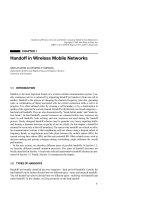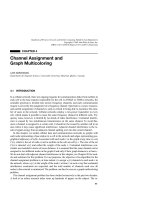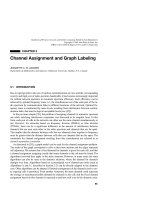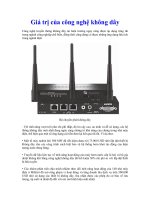Tài liệu Sổ tay của các mạng không dây và điện toán di động P15 pdf
Bạn đang xem bản rút gọn của tài liệu. Xem và tải ngay bản đầy đủ của tài liệu tại đây (302.47 KB, 22 trang )
CHAPTER 15
Mobile Ad Hoc Networks
SILVIA GIORDANO
Institute of Computer Communications and Applications, Swiss Federal Institute of Technology,
Lausanne, Switzerland
15.1 INTRODUCTION
Future information technology will be mainly based on wireless technology [49, 50, 56].
Traditional cellular and mobile networks are still, in some sense, limited by their need for
infrastructure (i.e., base stations, routers). For mobile ad hoc networks, this final limita-
tion is eliminated.
Ad hoc networks are key to the evolution of wireless networks [48]. Ad hoc networks
are typically composed of equal nodes that communicate over wireless links without any
central control. Although military tactical communication is still considered the primary
application for ad hoc networks, commercial interest in this type of networks continues to
grow. Applications such as rescue missions in times of natural disasters, law enforcement
operations, commercial and educational use, and sensor networks are just a few possible
commercial examples.
Ad hoc wireless networks inherit the traditional problems of wireless and mobile com-
munications, such as bandwidth optimization, power control, and transmission quality en-
hancement. In addition, the multihop nature and the lack of fixed infrastructure generates
new research problems such as configuration advertising, discovery, and maintenance, as
well as ad hoc addressing and self-routing (see Figure 15.1).
In mobile ad hoc networks, topology is highly dynamic and random. In addition, the
distribution of nodes and, eventually, their capability of self-organizing play an important
role. The main characteristics can be summarized as follows:
ț The topology is highly dynamic and frequent changes in the topology may be hard
to predict.
ț Mobile ad hoc networks are based on wireless links, which will continue to have a
significantly lower capacity than their wired counterparts.
ț Physical security is limited due to the wireless transmission.
ț Mobile ad hoc networks are affected by higher loss rates, and can experience higher
delays and jitter than fixed networks due to the wireless transmission.
ț Mobile ad hoc network nodes rely on batteries or other exhaustible power supplies
for their energy. As a consequence, energy savings are an important system design
325
Handbook of Wireless Networks and Mobile Computing, Edited by Ivan Stojmenovic´
Copyright © 2002 John Wiley & Sons, Inc.
ISBNs: 0-471-41902-8 (Paper); 0-471-22456-1 (Electronic)
criterion. Furthermore, nodes have to be power-aware: the set of functions offered
by a node depends on its available power (CPU, memory, etc.).
A well-designed architecture for mobile ad hoc networks involves all networking lay-
ers, ranging from the physical to the application layer.
Despite the fact that the management of the physical layer is of fundamental impor-
tance, there has been very little research in this area: nodes in mobile ad hoc networks are
confronted with a number of problems, which, in existing mobile networks, are solved by
the base stations. The solution space ranges from hierarchical cell structures (a self-
organized pendant of cellular networks) to completely ad hoc, stochastic allocations. Pow-
er management is of paramount importance. General strategies for saving power need to
be addressed, as well as adaptation to the specifics of nodes of general channel and source
coding methods, radio resource management, and multiple access.
Mobile ad hoc networks do not rely on one single technology; instead, they should be
able to capitalize on technology advances. One challenge is to define a set of abstractions
that can be used by the upper layers and still not preclude the use of new physical layer
methods as they emerge. Primitives of such an abstraction are, for example, the capabili-
ties and covering ranges of multicast and unicast channels.
Information such as node distribution, network density, link failures, etc., must be
shared among layers, and the MAC layer and the network layer need to collaborate in or-
der to have a better view of the network topology and to optimize the number of messages
in the network.
Mobile ad hoc networks have the unique characteristic of being totally independent
from any authority or infrastructure, providing great potential for the users. In fact, rough-
ly speaking, two or more users can become a mobile ad hoc network simply by being close
enough to meet the radio constraints, without any external intervention.
Moreover, telecommunication networks are expected to grow with the advent of new
(and totally unexpected) applications. Although in the past telecommunication networks
were studied and developed as separate building blocks, for users of mobile ad hoc net-
works the interaction between higher layers and lower layers is essential.
326
MOBILE AD HOC NETWORKS
Figure 15.1 A mobile ad hoc network.
Resilient and adaptive applications that can continue to perform effectively under de-
graded conditions can significantly enhance network operations from a user’s perspective.
Such applications can also significantly ease the design pressure in complex engineering
areas such as quality of service (QoS) and mobile routing at the network layer [46].
As illustrated in Figure 15.2, communication among layers is the only practical approach
to a demanding environment that raises issues that rarely occur in other networks [35].
This chapter focuses on the state of the art in mobile ad hoc networks and highlights
some of the emerging technologies, protocols, and approaches at different layers for real-
izing network services for users on the move in areas with possibly no preexisting com-
munication infrastructures.
The remainder of this chapter is organized as follows. In Section 15.2 we present the
layered architecture of mobile ad hoc networks and introduce some relevant concepts and
technologies that will be discussed further. In Section 15.3 we cover some emerging MAC
technologies that can be used for constructing a mobile ad hoc network: IEEE 802.11 and
Bluetooth. In Section 15.4 we provide an overview of the standardization efforts of the In-
ternet Engineering Task Force. Section 15.5 introduces a human-based approach to a par-
ticular class of mobile ad hoc networks, referred to as self-organizing networks. In Section
15.6, we present mobile ad hoc networking from the users/applications point of view. Fi-
nally, Section 15.7 provides a discussion on the future evolution and applications of mo-
bile ad hoc networks.
15.2 LAYERED ARCHITECTURE OF MOBILE AD HOC NETWORKS
The precursor of ad hoc networking technology was the packet radio network [33, 34].
Packet radio applies packet communications to a radio channel rather than to a wire-based
15.2 LAYERED ARCHITECTURE OF MOBILE AD HOC NETWORKS
327
Figure 15.2 Complexity of mobile ad hoc networks. The network can be highly dynamic, imply-
ing that (1) traditional routing algorithms will either not stabilize or will generate many routing up-
dates and (2) rapid response to topology change is needed [35].
Rapid reaction to
topology changes
Efficiency
Highly dynamic,
unpredictable network
Relatively scarce
link resources
Possible
shared link
Relatively low
bandwidth
Many updates with
traditional routing
Multiple algorithms
at different timescales
Multiple
algorithms
Integrated algorithms
which can be complex
and may violate layering
Control over
transmission parameters
Access to
overheard
information
medium. This technology can be used to create LANs that link devices, as well as to pro-
vide gateways to other network systems and databases [11]. The current version, referred
to as “distributed packet radio,” is completely distributed, permitting flexible and rapid
adaptation to changes and to mobility.
Later research focused mainly on cellular systems that are, in principle, single-hop
wireless systems. Within the framework of multihop wireless systems, research communi-
ties worked on projects that mainly addressed medium access control and routing issues.
Appropriate physical and data link protocols need to be developed for wireless mobile
networks in conjunction with the embedded MAC sublayer and the higher-level network-
ing and/or transport layers.
A key aspect of wireless communications is the radio propagation channel, which in-
troduces cochannel and adjacent channel interference among users. Exploiting the physi-
cal environment and controlling the location of radio users as much as possible is one way
to mitigate interference, but this is not realistic for uncoordinated wireless systems that
share the same radio spectrum. For ad hoc networks that share the same spectrum, new
methods of cooperation are required to permit coexistence. Such methods are difficult to
research without real-world channel models and simulation methodologies; there is still
fundamental work to be done in this area [49].
There have been many successful attempts to reduce the power consumption of digital
circuits. Today, there are many different techniques known, starting from the circuit level
[19] and reaching into architecture and software. Clearly, the energy necessary to execute a
given algorithm very much depends on the implementation technology. For current radio
software projects, emphasis has been placed on low power consumption, see [66] and [55].
Current research covers lower-layer issues such as modulation and coding, multiple ac-
cess, wireless/mobile protocols, and location protocols. In the United States, most of the
research in this and in the sensor network fields is sponsored by NSF (Advanced Net-
working Infrastructure and Research Division and Computer–Communications Research
Division) and DARPA (Microelectromechanical Systems and Global Mobile Information
Systems); see [3, 14, 23, 42, 51]. Similar projects are conducted in Europe in the mobility
and personal communications networks domain [2], in ETSI [25], in some universities
(e.g., [20]), by industrial consortia (e.g., [8, 60]), and by operators (e.g., [59]).
The MAC layer specified in the IEEE 802.11 standard [29] or its variations, is typical-
ly applied in the existing ad hoc network projects. The standard is built on the carrier
sense multiple access with collision avoidance (CSMA/CA) scheme that is extended with
the capability for short channel allocation and acknowledgment control messages. In
802.11, all the nodes must use the same channel. All nodes can communicate with every
other node that is within range. In 802.11 standard can be a good platform to implement a
one-level, multihop architecture because of its extreme simplicity. IEEE 802.11 is a digital
wireless data transmission standard aimed at providing a wireless LAN (WLAN) between
portable computers and between portable computers and a fixed network infrastructure.
Although it is easy to foresee that the WLANs will be the solution for home and office au-
tomation [5], the existing standard does not support multihop systems, and since only one
frequency can be used, the achievable capacity is limited. HomeRF [27] is seen as the
main contender to 802.11 for use in home networks. This is based on the shared wireless
access protocol (SWAP) that defines a new common interface supporting wireless voice
328
MOBILE AD HOC NETWORKS
and data networking in the home. Wireless LAN technology is already widely commer-
cially available. The main aim of Bluetooth technology [8, 10] is to guarantee interoper-
ability between different applications on devices in the same area that may run over differ-
ent protocol stacks, and therefore to provide a solution for wireless personal area
networks. Section 15.2 covers the MAC layer in more detail.
The Internet Engineering Task Force (IETF) Working Group on Mobile Ad Hoc NET-
works (MANET) is standardizing routing in ad hoc networks. The group studies routing
specifications, with the goal of supporting networks scaling up to hundreds of routers
[40]. The work of MANET relies on other existing IETF standards such as mobile IP and
IP addressing. Most of the currently available solutions are not designed to scale to more
than a few hundred nodes. Section 15.3 presents some aspects of the protocols designed to
extend Internet services to mobile ad hoc network users.
Designing protocols that scale to very large wireless networks is among the main chal-
lenges of research in this field, and there are several factors that distinguish different pro-
tocols for realizing wide-area, mobile ad hoc networks, as explained in Section 15.4.
Location management functions make it possible to access a network regardless of the
user’s location. Not limited only to users, it is easily imagined that entire networks might
one day be mobile as well, e.g., networks on aircraft or other vehicles. Location manage-
ment works at several layers and is, therefore, a complex process [48].
The well-established techniques to locate mobile devices in infrastructure-based net-
works, even if they contain concepts to deal with nomadic nodes, are not useful as soon as
infrastructure is no longer available.
As stated by the Zeroconf Working Group of the IETF [76], the common TCP/IP proto-
cols commonly used for the network configuration, e.g., DHCP, DNS, MADCAP, and
LDAP, are not appropriate for mobile ad hoc networks because they must be configured
and maintained by an administrative staff.
For all these networks, an administrative staff will not exist, and the users of these net-
works have neither the time nor inclination to learn network administration skills. Instead,
these networks need protocols that require zero user configuration and administration.
New approaches are being investigated, as described in Chapter 21 of this book.
Bootstrapping protocols and a basic infrastructure must be available, however. Current
schemes on the network layer are incorporated in Bluetooth and related technologies [8],
whereas Jini [31] is the most prominent example of a system enabling federations of ser-
vices and clients on the services layer.
At the service level, for IP networks, the service location protocol (SLP) proposed by
the Internet Engineering Task Force [72] is used; other examples are SSDP (simple ser-
vice discovery protocol) in universal plug and play networks [71] that are XML based, or
SDP (service discovery protocol) in Bluetooth [8].
Finally, also at the application level, the location requires the choice of a topology, ad-
dressing within the topological space, and location- and distance-dependent operations, as
in [30] and [47].
Information transport and its associated infrastructure must demonstrate high assur-
ance capabilities in times of crisis and attack, as well as under normal conditions. Scarce
attention has been given to security in mobile ad hoc networks so far. This computing en-
vironment is very different from the ordinary computing environment. In many cases, mo-
15.2 LAYERED ARCHITECTURE OF MOBILE AD HOC NETWORKS
329
bile computers will be connected to the network via wireless links. Such links are particu-
larly vulnerable to passive eavesdropping, active replay attacks, and other active attacks
[18]. To our knowledge, few works have been published on this topic (see [64], [77], and
[18]), and much effort is required in order to overcome the vulnerability (in particular, the
privacy vulnerability) of this type of network with an integrated approach that is not limit-
ed at the routing layer.
Security in networks (including ad hoc networks) mainly involves confidentiality and
integrity of information, as well as legitimate use and availability of services [21]. In mil-
itary applications, confidentiality is considered to be the most important security objec-
tive. In civilian scenarios, the major user requirement is availability [65].
Denial-of-service attacks are typically impossible to prevent. However, they can be
made very expensive by exploiting the inherent redundancy of ad hoc networks [77]. For
instance, a packet can be sent to its destination via several disjoint routes, which makes its
interception considerably more expensive for the attacker.
A fundamental tool to achieve network security objectives is cryptography. The chal-
lenge of using cryptography in mobile ad hoc networks is the management of crypto-
graphic keys. Since nodes are mobile, their interactions are spontaneous and unpre-
dictable, which makes public key cryptography more appropriate in this setting than
conventional cryptography. The most widely accepted solution for the public key manage-
ment problem is based on public key certificates that are issued by (online) certification
authorities and distributed via (online) key distribution servers.
The design issues associated with the real-time services become particularly important
for multimedia delivery, e.g., voice, images and video. The multimedia data will typically
be provided with some form of coding and be in the form of multiple data streams each
with their own QoS requirements.
New networking technologies engender a radical transformation in high-end applica-
tions and the manner in which researchers and educators throughout the globe access and
manipulate resources [52]. There are limitless possibilities for mobile applications. Al-
though potential applications exist in commerce, education, medicine, government, public
safety, and numerous other areas, market and social forces will determine which are ac-
cepted or rejected [48].
Indeed, the telecommunications industry expects exponential growth of subscribers for
wireless services (PCS, GSM, and mobile IP). This growth will occur in an environment
characterized by rapid development and migration of end-user applications.
A related characteristic is the evolution of new applications, made possible by mobility
and ubiquitous access that would normally not be found in fixed networks. Researchers in
the field must understand and explore these problems, finding solutions that will integrate
efficiently with existing systems and endure over time [48].
In mobile computing, geographic location is critical for distributed applications. Sever-
al projects currently address the problem of location-aware applications [30, 39, 47, 70].
Information management in highly distributed and mobile applications recently became
the core of a new field called cooperative information systems [17].
Notable applications of ad hoc networks are sensor networks, which can be used for
several purposes such as hospital instrumentation or atmospheric instrumentation to pre-
dict weather [67], as well as social networks [41, 57].
330
MOBILE AD HOC NETWORKS
Information technologies are an integral part of our lives, businesses, and society. The
wide acceptance of Internet standards and technologies is helping us build global comput-
er networks capable of connecting everything and reaching everyone [56].
Almost daily, new wired or wireless e-business models emerge: e-shopping, e-procure-
ment, e-auctions, e-malls, third-party marketplaces, virtual communities, value chain ser-
vice providers, value chain integrators, collaborative platforms, information brokerages
and trusts [69]. Mobile ad hoc networks are envisioned to naturally support these applica-
tions. However, in order to realize these new technologies, it is necessary to understand re-
lated economic, social, and policy issues in much greater depth.
15.3 MAC LAYER
We present here two emerging technologies for wireless media interfaces that can be used
for building a mobile ad hoc network: the IEEE 802.11 standard for wireless LANs
(WLANs) [1, 29] and the Bluetooth technology [8, 10] which is the de-facto standard for
wireless personal area networks (WPAN). A WLAN is a wireless network characterized
by a small scope, whereas a WPAN is a network constituted by connected devices placed
inside a circle with a radius of 10 meters. The Bluetooth Special Interest Group releases
the Bluetooth specifications. In addition, the IEEE 802.15 Working Group for Wireless
Personal Area Networks has started a project to publish and approve a standard derived
from the Bluetooth specifications.
Bluetooth and IEEE 802.11 technologies also exemplify the two categories in which
multiple access networks can be roughly categorized: random access (e.g., CSMA,
CSMA/CD) and demand assignment (e.g., Token Ring) [5]. Due to the inherent flexibility
of random access systems (e.g., random access allows unconstrained movement of mobile
hosts) the IEEE K.11 standard committee decided to adopt a random access, CSMA-
based scheme for WLANs. On the other hand, demand assignment access schemes are
more suitable for an environment that needs to provide guarantees on the Quality of Ser-
vice (QoS) perceived by its users. The Bluetooth technology that is designed to support
delay-sensitive applications (such as voice traffic) beyond data traffic adopts a (implicit)
token-based access method.
15.3.1 IEEE 802.11
IEEE 802.11 is a digital wireless data transmission standard in the 2.4 GHz ISM band
aimed at providing wireless LANs between portable computers and between portable
computers and a fixed network infrastructure. This standard defines a physical layer and a
MAC layer. Three different technologies are used as an air interface physical layer for con-
tention-based and contention-free access control: infrared, frequency hopping, and direct
sequence spread spectrum. The most popular technology is the direct sequence spread
spectrum, which can offer a bit rate of up to 11 Mbps in the 2.4 GHz band, and, in the fu-
ture, up to 54 Mbps in the 5 GHz band. The basic access method in the IEEE 802.11 MAC
protocol is the distributed coordination function (DCF) which is a carrier sense multiple
access with collision avoidance (CSMA/CA) MAC protocol.
15.3 MAC LAYER
331
802.11 can be used to implement either an infrastructure-based W-LAN architecture or
an ad hoc W-LAN architecture (see Figure 15.3). In an infrastructure-based network, there
is a centralized controller for each cell, often referred to as an access point. The access
point is normally connected to the wired network, thus providing the Internet access to
mobile devices. All traffic goes through the access point, even when it is sent to a destina-
tion that belongs to the same cell. Neighboring cells can use different frequencies to avoid
interference and increase the cell’s capacity. All the cells are linked together to form a sin-
gle broadcast medium at the LLC layer. A so-called distribution system handles the pack-
et forwarding toward destination devices outside the cell across the wired network infra-
structure. The distribution medium that forwards packets between the access points is not
defined by the standard. It is possible to use a wireless link to connect the different access
points, for example an 802.11 ad hoc link in another frequency. Such a feature permits the
implementation of a two-level, multihop architecture.
In the ad hoc mode, every 802.11 device in the same cell, or independent basic service
set (IBSS), can directly communicate with every other 802.11 device within the cell, with-
out the intervention of a centralized entity or an infrastructure. In an ad hoc cell, identified
by an identification number (IBSSID) that is locally managed, all devices must use a pre-
defined frequency. Due to the flexibility of the CSMA/CA algorithm, it is sufficient to
synchronize devices to a common clock for them to receive or transmit data correctly.
Synchronization acquirement is a scanning procedure used by an 802.11 device for join-
ing an existing IBSS. If the scanning procedure does not result in finding any IBSSs, the
station may initialize a new IBSS. Synchronization maintenance is implemented via a dis-
tributed algorithm, based on the transmission of beacon frames at a known nominal rate,
which is performed by all of the members of the IBSS. Additionally, given the constraints
332
MOBILE AD HOC NETWORKS
Figure 15.3 Infrastructure and ad hoc networks.
Gateway
Internet
Ethernet (or something else)
Access
Point
Access
Point
Access
Point
Ad Hoc
Network
Infrastructure Network
IBSS
BSS









